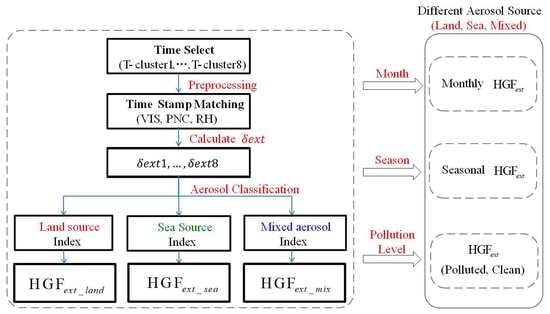Characteristics of Aerosol Extinction Hygroscopic Growth in the Typical Coastal City of Qingdao, China
Abstract
1. Introduction
2. Materials and Methods
2.1. Data
2.1.1. Field Experiment Data
- The automatic weather station WXT520 (Vaisala, Helsinki, Finland) was used to collect near-surface meteorological data, equipped with 6 weather sensors to measure the atmospheric pressure (P), atmospheric temperature (T), RH, wind direction (WD), wind speed (WS). The WXT520 was mounted on a flux-measuring tower at 2 m above the ground to collect the meteorological data every 5 s during the experiment. The specific performances of the WXT520 sensors refer to Villagrán’s paper [44].
- The 6000 forward-scattering visibility meter (Belfort Instrument, Baltimore, MA, USA) was used to collect the VIS. The infrared LED transmitter transmits the light into a sampler, and the receiver collects the forward-scattered light and calculates the extinction to obtain the atmospheric VIS, and it is one of the most commonly used instruments for atmospheric visibility measurement. The device can be deployed and used without frequent maintenance. The temporal resolution of the VIS is 5 s. For more technical parameters, please refer to Dr. Dongsheng Ji’s research [45].
- The OPC was used to collect the aerosol PNC. The OPC is designed to measure aerosol particles such as floating dust. Theoretically, the PNC and the PSD are obtained through the light scattering characteristics of the particles according to the Mie scattering theory [46]. In this paper, we used the DLJ-92 multi-channel OPC developed by the AIOFM, CAS [47]. The detection range of particle diameter size is 0.3–12 μm [47]. The temporal resolution of the OPC data is 60 s in this research.
2.1.2. Remote Sensing and Reanalysis Data
- (1)
- GDAS data
- (2)
- MODIS AOD data
2.2. Methodology
3. Results and Discussion
3.1. Monthly and Seasonal Characteristics of Atmospheric Aerosols in Qingdao
3.1.1. Data Preprocessing
3.1.2. AOD and VIS in Qingdao
3.2. Analysis of Aerosol Source
3.3. Characteristics of Aerosol Extinction HG Factor
3.3.1. Monthly Characteristics in Qingdao
- (1)
- Select the time of all backward trajectories in each clustering result;
- (2)
- Match the VIS, PNC and RH values according to the selected time in Step 1;
- (3)
- Calculate the average extinction coefficient () of each clustering result using Equation (1) to analyze the relationship between and RH, then form a new array against RH;
- (4)
- Classify all the , , corresponding to different aerosol sources in each month, using the aerosol source results identified in Table 2;
- (5)
- Calculate the aerosol extinction HG factor (, and ) for all aerosol types using Equation (2), and establish the power-law curve models for different aerosol types.
3.3.2. Seasonal Characteristics in Qingdao
3.3.3. Characteristics under Different Pollution Backgrounds in Qingdao
4. Conclusions
- Qingdao’s aerosol source is very complicated due to the special geographical location, a typical coastal area in northeastern China. The proportion of different aerosol sources in Qingdao varies greatly from month to month, and shows obvious seasonal fluctuations. The local aerosol sources are mostly terrestrial sources, with marine sources accounting for only about 10–20%, which is slightly higher in summer than that in autumn and winter. Terrestrial aerosols accounted for more than 40% of the total for the year.
- The local aerosol’s of different sources in Qingdao have relatively small monthly variations, but explicit a certain seasonal variation. The seasonal change is mainly manifested as the “floating” of the DPs, and the DP of marine aerosol (RH about 80%) is consistent in different seasons. The seasonal distributions of terrestrial and mixed aerosols’ DPs are different, decreasing as low as to RH = 60–70% in autumn and winter and rising to about RH = 85% in summer. The DPs of mixed- source aerosols are generally intermediate between terrestrial and marine source ones. These variations can be caused by atmospheric circulation and local pollution levels.
- Under the background of different pollution levels, the characteristics of local aerosol from different sources in Qingdao showed considerable discrepancy. In general, when the atmospheric background was relatively clean, the DPs of aerosols from different sources were almost the same (about RH = 80%), but when the pollution was heavy, the DPs of terrestrial aerosols were almost 20% lower than those of marine sources (in the period of heavy pollution, the DPs’ RH of terrestrial, mixed and marine aerosols are 50%, 60%, and 70%, respectively). Therefore, it is necessary to model the local aerosols in Qingdao based on different pollution backgrounds.
Author Contributions
Funding
Data Availability Statement
Acknowledgments
Conflicts of Interest
References
- IPCC. Climate Change 2007: The Physical Science Basis; Solomon, S., Qin, D., Manning, M., Chen, Z., Marquis, M., Averyt, K.B., Tignor, M., Miller, H.L., Eds.; Contribution of Working Group I to the Fourth Assessment Report of the Intergovernmental Panel on Climate Change; Cambridge University Press: Cambridge, UK; New York, NY, USA, 2007; 996p. [Google Scholar]
- IPCC. Climate Change 2013: The Physical Science Basis; Stocker, T.F., Qin, D., Plattner, G.-K., Tignor, M., Allen, S.K., Boschung, J., Nauels, A., Xia, Y., Bex, V., Midgley, P.M., Eds.; Contribution of Working Group I to the Fifth Assessment Report of the Intergovernmental Panel on Climate Change; Cambridge University Press: Cambridge, UK; New York, NY, USA, 2013; 1535p. [Google Scholar]
- Yan, H.R.; Wang, T.H. Ten Years of Aerosol Effects on Single-Layer Overcast Clouds over the US Southern Great Plains and the China Loess Plateau. Adv. Meteorol. 2020, 2020, 6719160. [Google Scholar] [CrossRef]
- Kaloshin, G.A. Modeling the Aerosol Extinction in Marine and Coastal Areas. IEEE Geosci. Remote Sens. Lett. 2021, 18, 376–380. [Google Scholar] [CrossRef]
- Chemistry, A.; Montilla, E.; Mogo, S.; Cachorro, V.E. Absorption, Scattering and Single Scattering Albedo of Aerosols Obtained from in Situ Measurements in the Subarctic Coastal Region of Norway. Atmos. Chem. Phys. Discuss. 2011, 11, 2161–2182. [Google Scholar]
- Covert, D.S.; Charlson, R.J.; Ahlquist, N.C. A Study of the Relationship of Chemical Composition and Humidity to Light Scattering by Aerosols. J. Appl. Meteor. 1972, 11, 968–976. [Google Scholar] [CrossRef]
- Ding, J.; Zhang, Y.F.; Zhao, P.S.; Tang, M.; Xiao, Z.M.; Zhang, W.H.; Zhang, H.T.; Yu, Z.J.; Du, X.; Li, L.W.; et al. Comparison of size-resolved hygroscopic growth factors of urban aerosol by different methods in Tianjin during a haze episode. Sci. Total Environ. 2019, 678, 618–626. [Google Scholar] [CrossRef] [PubMed]
- Wang, Q.; Mao, J.D.; Zhao, H.; Sheng, H.J.; Zhou, C.Y.; Gong, X.; Rao, Z.M.; Zhang, Y. A Novel Lidar System for Profiling the Aerosol Hygroscopic Growth Factor. Measurement 2021, 171, 108825. [Google Scholar] [CrossRef]
- Stock, M.; Cheng, Y.F.; Birmili, W.; Massling, A.; Wehner, B.; Muller, T.; Leinert, S.; Kalivitis, N.; Mihalopoulos, N.; Wiedensohler, A. Hygroscopic Properties of Atmospheric Aerosol Particles over the Eastern Mediterranean: Implications for Regional Direct Radiative Forcing under Clean and Polluted Conditions. Atmos. Chem. Phys. 2011, 11, 4251–4271. [Google Scholar] [CrossRef]
- Gasparini, R.; Li, R.J.; Collins, D.R.; Ferrare, R.A.; Brackett, V.G. Application of Aerosol Hygroscopicity Measured at the Atmospheric Radiation Measurement Program’s Southern Great Plains Site to Examine Composition and Evolution. J. Geophys. Res.-Atmos. 2006, 111, D5. [Google Scholar] [CrossRef]
- Zhao, C.; Yu, Y.; Kuang, Y.; Tao, J.; Zhao, G. Recent Progress of Aerosol Light-Scattering Enhancement Factor Studies in China. Adv. Atmos. Sci. 2019, 36, 1015–1026. [Google Scholar] [CrossRef]
- Kacenelenbogen, M.; Redemann, J.; Vaughan, M.A.; Omar, A.H.; Russell, P.B.; Burton, S.; Rogers, R.R.; Ferrare, R.A.; Hostetler, C.A. An Evaluation of CALIOP/CALIPSO’s Aerosol-above-Cloud Detection and Retrieval Capability over North America. J. Geophys. Res.-Atmos. 2014, 119, 230–244. [Google Scholar] [CrossRef]
- Zuidema, P.; Redemann, J.; Haywood, J.; Wood, R.; Piketh, S.; Hipondoka, M.; Formenti, P. Smoke and Clouds above the Southeast Atlantic: Upcoming Field Campaigns Probe Absorbing Aerosol’s Impact on Climate. Bull. Am. Meteorol. Soc. 2016, 97, 1131–1135. [Google Scholar] [CrossRef]
- Jefferson, A.; Hageman, D.; Morrow, H.; Mei, F.; Watson, T. Seven Years of Aerosol Scattering Hygroscopic Growth Measurements from SGP: Factors Influencing Water Uptake. J. Geophys. Res.-Atmos. 2017, 122, 9451–9466. [Google Scholar] [CrossRef]
- Zieger, P.; Fierz-Schmidhauser, R.; Weingartner, E.; Baltensperger, U. Effects of Relative Humidity on Aerosol Light Scattering: Results from Different European Sites. Atmos. Chem. Phys. 2013, 13, 10609–10631. [Google Scholar] [CrossRef]
- Charlson, R.J.; Schwartz, S.E.; Hales, J.M.; Cess, R.D.; Coakley, J.A., Jr.; Hansen, J.E.; Hofmann, D.J. Climate Forcing by Anthropogenic Aerosols. Science 1992, 255, 5043. [Google Scholar] [CrossRef] [PubMed]
- Pilinis, C.; Pandis, S.N.; Seinfeld, J.H. Sensitivity of Direct Climate Forcing by Atmospheric Aerosols to Aerosol Size and Composition. J. Geophys. Res.-Atmos. 1995, 100, 18739–18754. [Google Scholar] [CrossRef]
- Zieger, P.; Kienast-Sjögren, E.; Starace, M.; Von Bismarck, J.; Bukowiecki, N.; Baltensperger, U.; Wienhold, F.G.; Peter, T.; Ruhtz, T.; Collaud Coen, M.; et al. Spatial Variation of Aerosol Optical Properties around the High-Alpine Site Jungfraujoch (3580 m a.s.L.). Atmos. Chem. Phys. 2012, 12, 7231–7249. [Google Scholar] [CrossRef]
- Wang, Z.; Chen, L.; Tao, J.; Liu, Y.; Hu, X.; Tao, M. An Empirical Method of RH Correction for Satellite Estimation of Ground-Level PM Concentrations. Atmos. Environ. 2014, 95, 71–81. [Google Scholar] [CrossRef]
- Knipping, E.M.; Dabdub, D. Impact of Chlorine Emissions from Sea-Salt Aerosol on Coastal Urban Ozone. Environ. Sci. Technol. 2003, 37, 275–284. [Google Scholar] [CrossRef]
- Wang, B.; Chen, Y.; Zhou, S.Q.; Li, H.W.; Wang, F.H.; Yang, T.J. The Influence of Terrestrial Transport on Visibility and Aerosol Properties over the Coastal East China Sea. Sci. Total Environ. 2019, 649, 652–660. [Google Scholar] [CrossRef]
- Li, Z.; Guo, J.; Ding, A.; Liao, H.; Liu, J.; Sun, Y.; Wang, T.; Xue, H.; Zhang, H.; Zhu, B. Aerosol and Boundary-Layer Interactions and Impact on Air Quality. Natl. Sci. Rev. 2017, 4, 810–833. [Google Scholar] [CrossRef]
- Liu, N.N.; Luo, T.; Han, Y.J.; Yang, K.X.; Zhang, K.; Wu, Y.; Weng, N.Q.; Li, X.B. Analysis of the Atmospheric Visibility Influencing Factors under Sea-Land Breeze Circulation. Opt. Express 2022, 30, 7356–7371. [Google Scholar] [CrossRef] [PubMed]
- Yu, D. Intuitionistic Fuzzy Theory Based Typhoon Disaster Evaluation in Zhejiang Province, China: A Comparative Perspective. Nat. Hazards. 2015, 75, 2559–2576. [Google Scholar] [CrossRef]
- Zhao, H.J.; Che, H.Z.; Wang, Y.Q.; Wang, H.; Ma, Y.J.; Wang, Y.F.; Zhang, X.Y. Investigation of the Optical Properties of Aerosols over the Coastal Region at Dalian, Northeast China. Atmosphere 2016, 7, 103. [Google Scholar] [CrossRef]
- Wang, Y.; Wang, J.; Levy, R.C.; Shi, Y.X.R.; Mattoo, S.; Reid, J.S. First Retrieval of AOD at Fine Resolution Over Shallow and Turbid Coastal Waters From MODIS. Geophys. Res. Lett. 2021, 48, 17. [Google Scholar] [CrossRef]
- Satheesh, S.K.; Moorthy, K.K.; Babu, S.S.; Vinoj, V.; Nair, V.S.; Beegum, S.N.; Dutt, C.B.S.; Alappattu, D.P.; Kunhikrishnan, P.K. Vertical structure and horizontal gradients of aerosol extinction coefficients over coastal India inferred from airborne lidar measurements during the Integrated Campaign for Aerosol, Gases and Radiation Budget (ICARB) field campaign. J. Geophys. Res. 2009, 114, D05204. [Google Scholar] [CrossRef]
- Montilla-Rosero, E.; Silva, A.; Jimenez, C.; Hernandez, R.; Saavedra, C. Optical Characterization of Lower Tropospheric Aerosols by the Southern East Pacific Lidar Station (Concepcion, Chile). J. Aerosol. Sci. 2016, 92, 16–26. [Google Scholar] [CrossRef]
- Zhang, Q.; Li, Z.; Wei, P.; Wang, Q.; Tian, J.; Wang, P.; Shen, Z.; Li, J.; Xu, H.; Zhao, Y.; et al. Insights into the Day-Night Sources and Optical Properties of Coastal Organic Aerosols in Southern China. Sci. Total Environ. 2022, 830, 154663. [Google Scholar] [CrossRef]
- Huang, X.F.; Sun, T.L.; Zeng, L.W.; Yu, G.H.; Luan, S.J. Black Carbon Aerosol Characterization in a Coastal City in South China Using a Single Particle Soot Photometer. Atmos. Environ. 2012, 51, 21–28. [Google Scholar] [CrossRef]
- Qu, W.J.; Wang, J.; Zhang, X.Y.; Wang, D.; Sheng, L.F. Influence of Relative Humidity on Aerosol Composition: Impacts on Light Extinction and Visibility Impairment at Two Sites in Coastal Area of China. Atmos. Res. 2015, 153, 500–511. [Google Scholar] [CrossRef]
- Tang, M.; Cziczo, D.J.; Grassian, V.H. Interactions of Water with Mineral Dust Aerosol: Water Adsorption, Hygroscopicity, Cloud Condensation, and Ice Nucleation. Chem. Rev. 2016, 116, 4205–4259. [Google Scholar] [CrossRef]
- Tang, M.; Chan, C.K.; Li, Y.J.; Su, H.; Ma, Q.; Wu, Z.; Zhang, G.; Wang, Z.; Ge, M.; Hu, M.; et al. A Review of Experimental Techniques for Aerosol Hygroscopicity Studies. Atmos. Chem. Phys. 2019, 19, 12631–12686. [Google Scholar] [CrossRef]
- Gu, W.; Li, Y.; Zhu, J.; Jia, X.; Lin, Q.; Zhang, G.; Ding, X.; Song, W.; Bi, X.; Wang, X.; et al. Investigation of Water Adsorption and Hygroscopicity of Atmospherically Relevant Particles Using a Commercial Vapor Sorption Analyzer. Atmos. Meas. Tech. 2017, 10, 3821–3832. [Google Scholar] [CrossRef]
- Eichler, H.; Cheng, Y.F.; Birmili, W.; Nowak, A.; Wiedensohler, A.; Brüggemann, E.; Gnauk, T.; Herrmann, H.; Althausen, D.; Ansmann, A.; et al. Hygroscopic Properties and Extinction of Aerosol Particles at Ambient Relative Humidity in South-Eastern China. Atmos. Environ. 2008, 42, 6321–6334. [Google Scholar] [CrossRef]
- Cheung, H.H.Y.; Yeung, M.C.; Li, Y.J.; Lee, B.P.; Chan, C.K. Relative Humidity- Dependent HTDMA Measurements of Ambient Aerosols at the HKUST Supersite in Hong Kong, China. Aerosol. Sci. Tech. 2015, 49, 643–654. [Google Scholar] [CrossRef]
- Hong, J.; Xu, H.B.; Tan, H.B.; Yin, C.Q.; Hao, L.Q.; Li, F.; Cai, M.F.; Deng, X.J.; Wang, N.; Su, H.; et al. Mixing State and Particle Hygroscopicity of Organic-Dominated Aerosols over the Pearl River Delta Region in China. Atmos. Chem. Phys. 2018, 18, 14079–14094. [Google Scholar] [CrossRef]
- Kong, L.W.; Hu, M.; Tan, Q.W.; Feng, M.; Qu, Y.; An, J.L.; Zhang, Y.H.; Liu, X.G.; Cheng, N.L. Aerosol Optical Properties under Different Pollution Levels in the Pearl River Delta (PRD) Region of China. J. Environ. Sci. 2020, 87, 49–59. [Google Scholar] [CrossRef]
- Xu, W.; Ovadnevaite, J.; Fossum, K.N.; Lin, C.S.; Huang, R.J.; O’Dowd, C.; Ceburnis, D. Aerosol Hygroscopicity and Its Link to Chemical Composition in the Coastal Atmosphere of Mace Head: Marine and Continental Air Masses. Atmos. Chem. Phys. 2020, 20, 3777–3791. [Google Scholar] [CrossRef]
- Fors, E.O.; Swietlicki, E.; Svenningsson, B.; Kristensson, A.; Frank, G.P.; Sporre, M. Hygroscopic Properties of the Ambient Aerosol in Southern Sweden—A Two Year Study. Atmos. Chem. Phys. 2011, 11, 8343–8361. [Google Scholar] [CrossRef]
- Li, J.; Zhang, Z.; Wu, Y.; Tao, J.; Xia, Y.; Wang, C.; Zhang, R. Effects of Chemical Compositions in Fine Particles and Their Identified Sources on Hygroscopic Growth Factor during Dry Season in Urban Guangzhou of South China. Sci. Total Environ. 2021, 801, 149749. [Google Scholar] [CrossRef]
- Liu, X.; Cheng, Y.; Zhang, Y.; Jung, J.; Sugimoto, N.; Chang, S.Y.; Kim, Y.J.; Fan, S.; Zeng, L. Influences of Relative Humidity and Particle Chemical Composition on Aerosol Scattering Properties during the 2006 PRD Campaign. Atmos. Environ. 2008, 42, 1525–1536. [Google Scholar] [CrossRef]
- Zhang, L.; Sun, J.Y.; Shen, X.J.; Zhang, Y.M.; Che, H.; Ma, Q.L.; Zhang, Y.W.; Zhang, X.Y.; Ogren, J.A. Observations of Relative Humidity Effects on Aerosol Light Scattering in the Yangtze River Delta of China. Atmos. Chem. Phys. 2015, 15, 8439–8454. [Google Scholar] [CrossRef]
- Villagrán, V.; Montecinos, A.; Franco, C.; Muñoz, R.C. Environmental Monitoring Network along a Mountain Valley Using Embedded Controllers. Measurement 2017, 106, 221–235. [Google Scholar] [CrossRef]
- Ji, D.; Li, L.; Pang, B.; Xue, P.; Wang, L.; Wu, Y.; Zhang, H.; Wang, Y. Characterization of Black Carbon in an Urban-Rural Fringe Area of Beijing. Environ. Pollut. 2017, 223, 524–534. [Google Scholar] [CrossRef] [PubMed]
- Bohren, C.F. Absorption and Scattering of Light by Small Particles; Wiley: Hoboken, NJ, USA, 1983. [Google Scholar]
- Meng, G.; Li, X.; Qin, W.; Liu, Z.; Lu, X.; Dai, C.; Miao, X. Research on the Characteristics of Aerosol Size Distribution and Complex Refractive Index in Typical Areas of China. Infrared Laser Eng. 2018, 47, 1–7. [Google Scholar]
- Kleist, D.T.; Parrish, D.F.; Derber, J.C.; Treadon, R.; Wu, W.S.; Lord, S. Introduction of the GSI into the NCEP Global Data Assimilation System. Weather 2009, 24, 1691–1705. [Google Scholar] [CrossRef]
- Kanniah, K.D.; Kaskaoutis, D.G.; San Lim, H.; Latif, M.T.; Kamarul Zaman, N.A.F.; Liew, J. Overview of Atmospheric Aerosol Studies in Malaysia: Known and Unknown. Atmos. Res. 2016, 182, 302–318. [Google Scholar] [CrossRef]
- Sayer, A.M.; Hsu, N.C.; Bettenhausen, C.; Ahmad, Z.; Holben, B.N.; Smirnov, A.; Thomas, G.E.; Zhang, J. SeaWiFS Ocean Aerosol Retrieval (SOAR): Algorithm, Validation, and Comparison with Other Data Sets. J. Geophys. Res.-Atmos. 2012, 117, D03206. [Google Scholar] [CrossRef]
- Hsu, N.C.; Jeong, M.; Bettenhausen, C.; Sayer, A.M.; Hansell, R.; Seftor, C.S.; Huang, J.; Tsay, S. Enhanced Deep Blue Aerosol Retrieval Algorithm: The Second Generation. J. Geophys. Res.-Atmos. 2015, 118, 9296–9315. [Google Scholar] [CrossRef]
- Titos, G.; Cazorla, A.; Zieger, P.; Andrews, E.; Lyamani, H.; Granados-Muñoz, M.J.; Olmo, F.J.; Alados-Arboledas, L. Effect of Hygroscopic Growth on the Aerosol Light-Scattering Coefficient: A Review of Measurements, Techniques and Error Sources. Atmos. Environ. 2016, 141, 494–507. [Google Scholar] [CrossRef]
- Tijjani, B.I.; Aliyu, A.; Shuaibu, F. The Effect of Hygroscopic Growth on Continental Aerosols. Open J. Appl. Sci. 2013, 03, 381–392. [Google Scholar] [CrossRef]
- Zhang, X.; Massoli, P.; Quinn, P.K.; Bates, T.S.; Cappa, C.D. Hygroscopic Growth of Submicron and Supermicron Aerosols in the Marine Boundary Layer. J. Geophys. Res.-Atmos. 2014, 119, 8384–8399. [Google Scholar] [CrossRef]
- Liu, J.M.; Huang, H.; Wang, X.Z. Characteristics and Environment Effects of Land Sea Breeze along the Huludao Coast. Meteor. Environ. Sci. 2019, 42, 79–85. (In Chinese) [Google Scholar]
- Cui, J.M.; Huang, J.P.; Zhou, C.H.; Jiao, S.M.; Yuan, C.S.; Bao, Y.X.; Xie, X.J.; Wang, L. Temporal-spatial Variations of Visibility and Its Affecting Factors in Jiangsu Province. J. Trop. Meteorol. 2015, 31, 700–712. (In Chinese) [Google Scholar]
- Zhu, C.W.; Cao, N.W.; Yang, F.K.; Yang, S.B.; Xie, Y.H. Micro Pulse Lidar Observations of Aerosols in Nanjing. Laser. Optoelectron. P 2015, 52, 050101. (In Chinese) [Google Scholar]
- Sun, L.E.; Sun, L.; Cui, T.W.; Huang, J.Y.; Kong, J.W. Observation and Analysis of Aerosol Optical Depth in Qingdao Coastland. J. Qingdao Univ. 2012, 25, 51–56. (In Chinese) [Google Scholar]
- Seng, L.F.; Shen, L.L.; Li, X.Z.; Liu, F. Studies on the Application of Empirical Formulae to the Calculation of Horizontal Visibility in Qingdao Coastal Area. Period. Ocean Univ. China 2009, 39, 877–882. (In Chinese) [Google Scholar]
- Li, X.M.; Dong, Z.P.; Chen, C.; Dong, Y.; Du, C.L.; Peng, Y. Study of Influence of Aerosol on Atmospheric Visibility in Guanzhong Region of Shaanxi Province. Plateau Plateau Meteorol. 2014, 33, 1289–1296. (In Chinese) [Google Scholar]
- Draxler, R.R.; Hess, G.D. An Overview of the HYSPLIT_4 Modelling System for Trajectories, Dispersion and Deposition. Aust. Meteorol. Mag. 1998, 47, 295–308. [Google Scholar]
- Wang, Y.Q.; Zhang, X.Y.; Draxler, R.R. TrajStat: GIS-Based Software That Uses Various Trajectory Statistical Analysis Methods to Identify Potential Sources from Long-Term Air Pollution Measurement Data. Environ. Modell. Softw. 2009, 24, 938–939. [Google Scholar] [CrossRef]
- Rico-Ramirez, M.A.; Cluckie, I.D.; Shepherd, G.; Pallot, A. MeteoInfo: GIS Software for Meteorological Data Visualization and Analysis. Meteorol. Appl. 2007, 14, 117–129. [Google Scholar] [CrossRef]
- Kasten, F. Visibility Forecast in the Phase of Pre-Condensation. Tellus 1969, 21, 631–635. [Google Scholar] [CrossRef]
- Gkikas, A.; Basart, S.; Hatzianastassiou, N.; Marinou, E.; Amiridis, V.; Kazadzis, S.; Pey, J.; Querol, X.; Jorba, O.; Gasso, S.; et al. Mediterranean Intense Desert Dust Outbreaks and Their Vertical Structure Based on Remote Sensing Data. Atmos. Chem. Phys. 2016, 16, 8609–8642. [Google Scholar] [CrossRef]
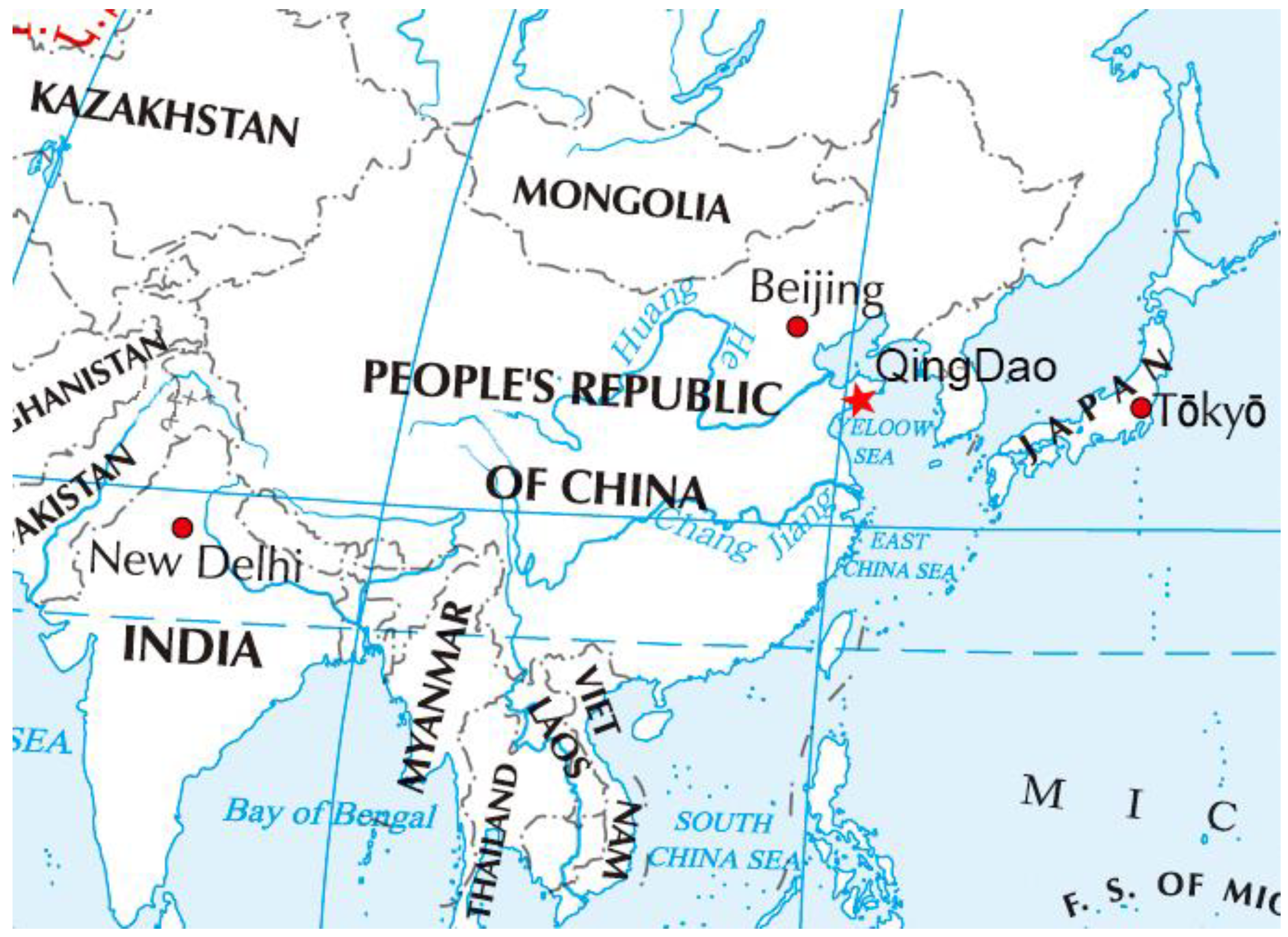
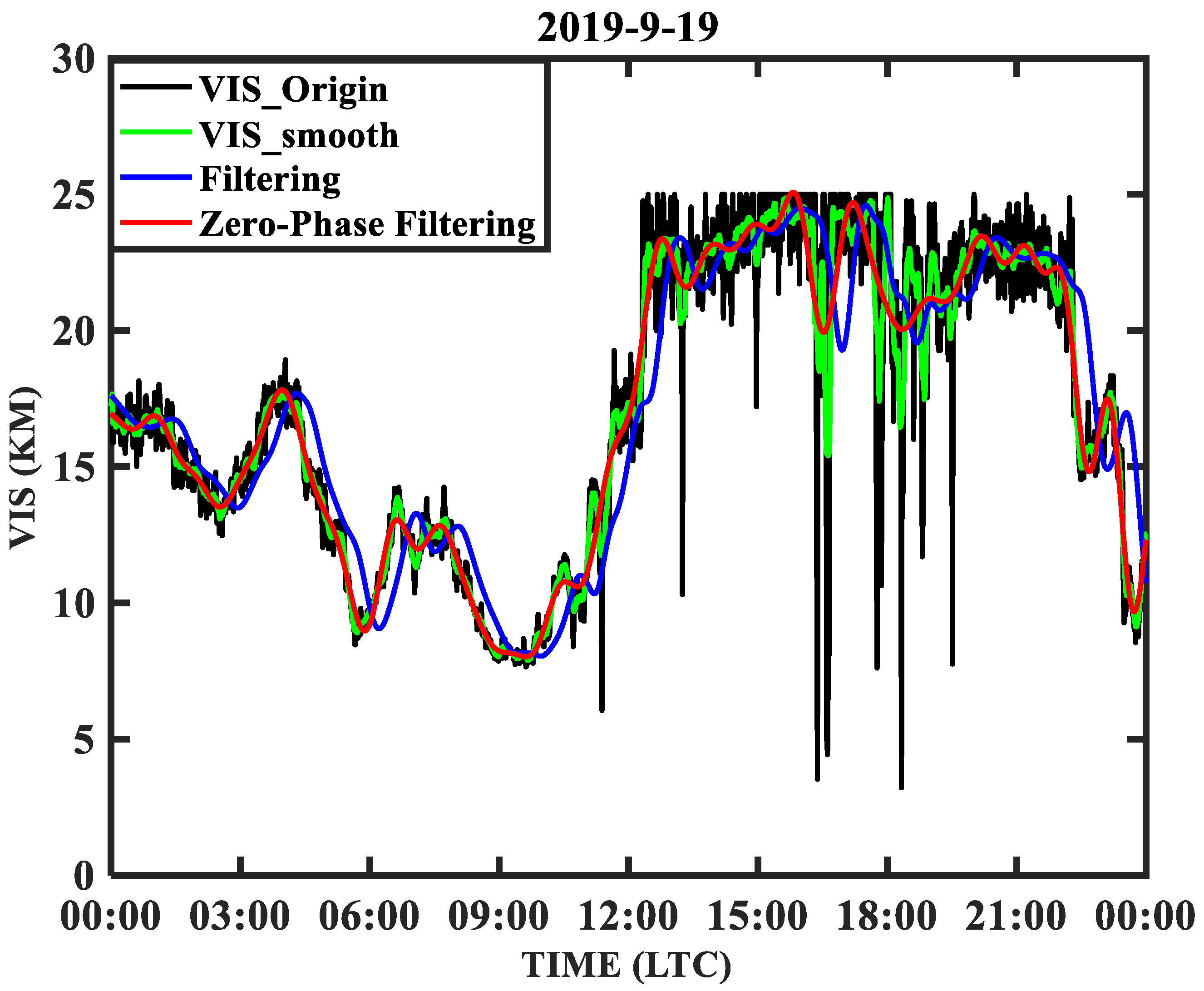
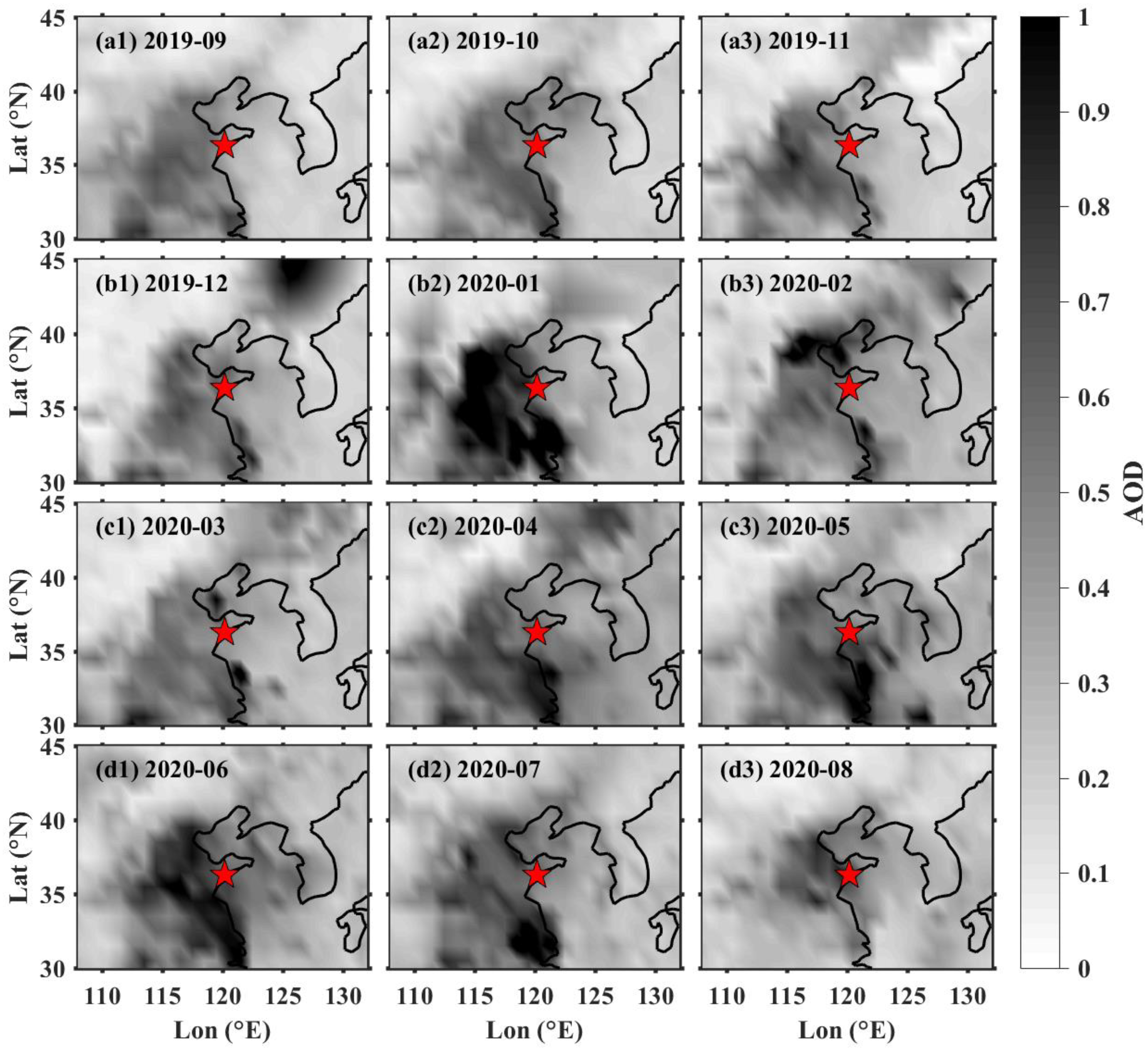

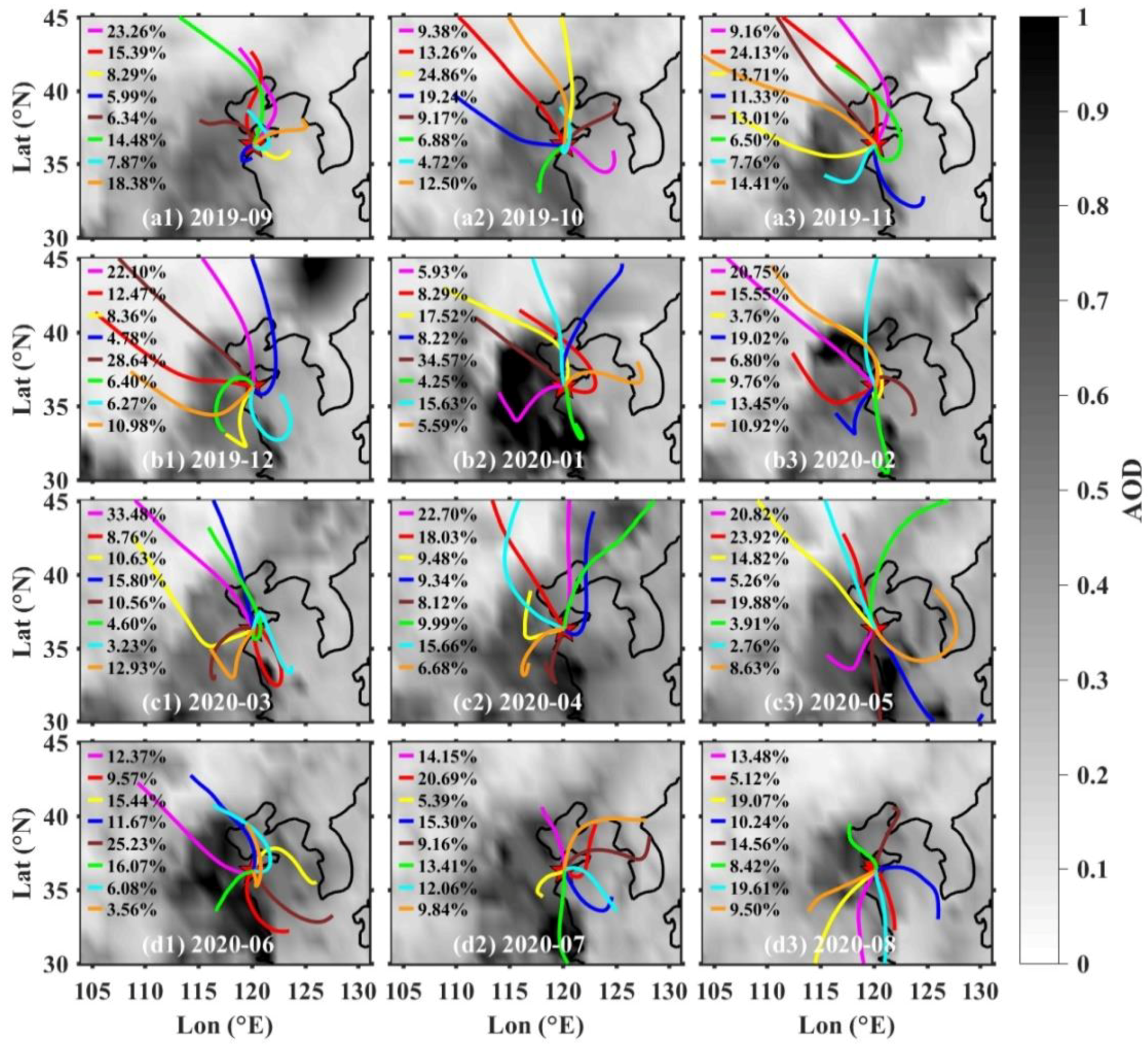

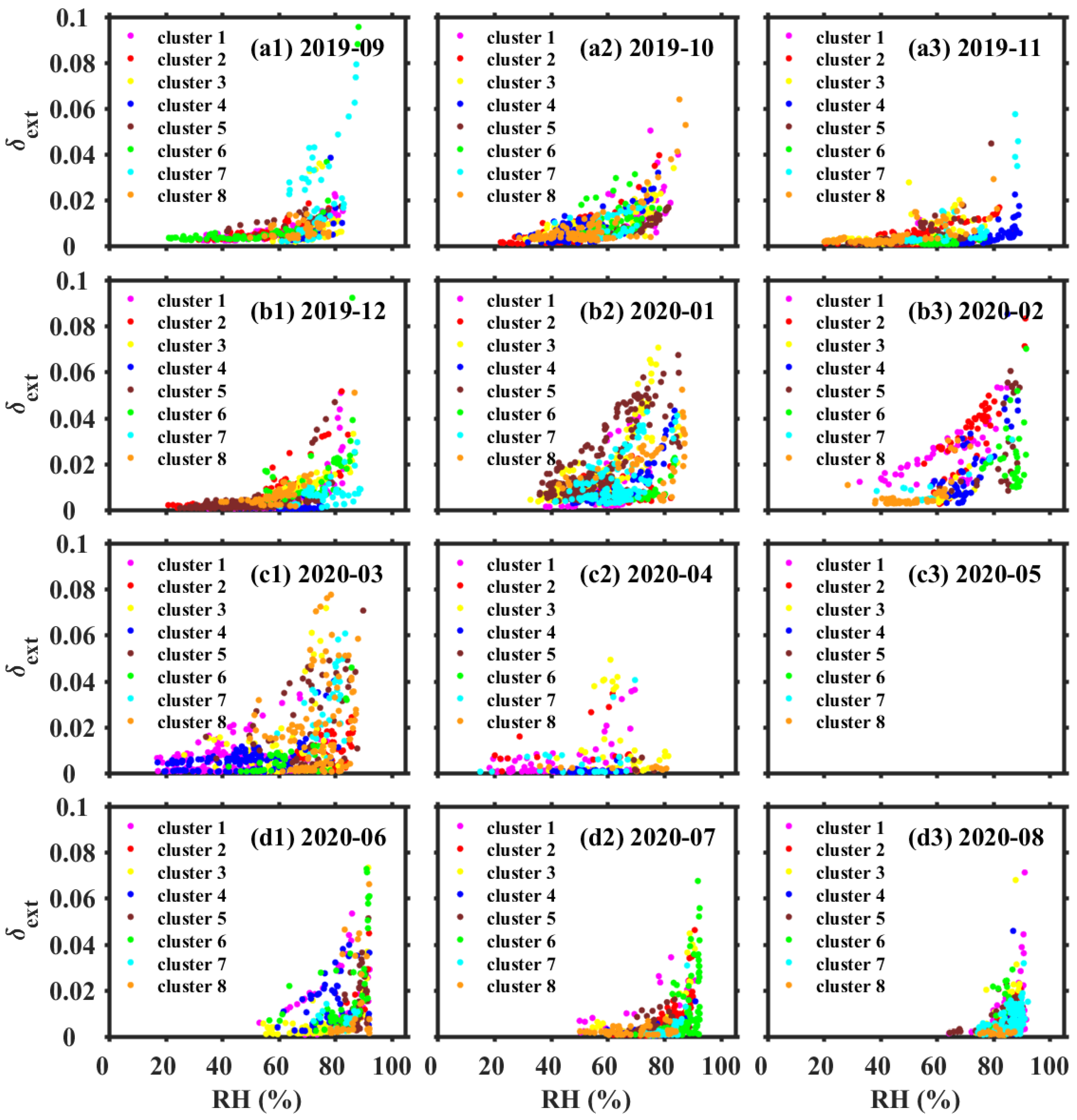

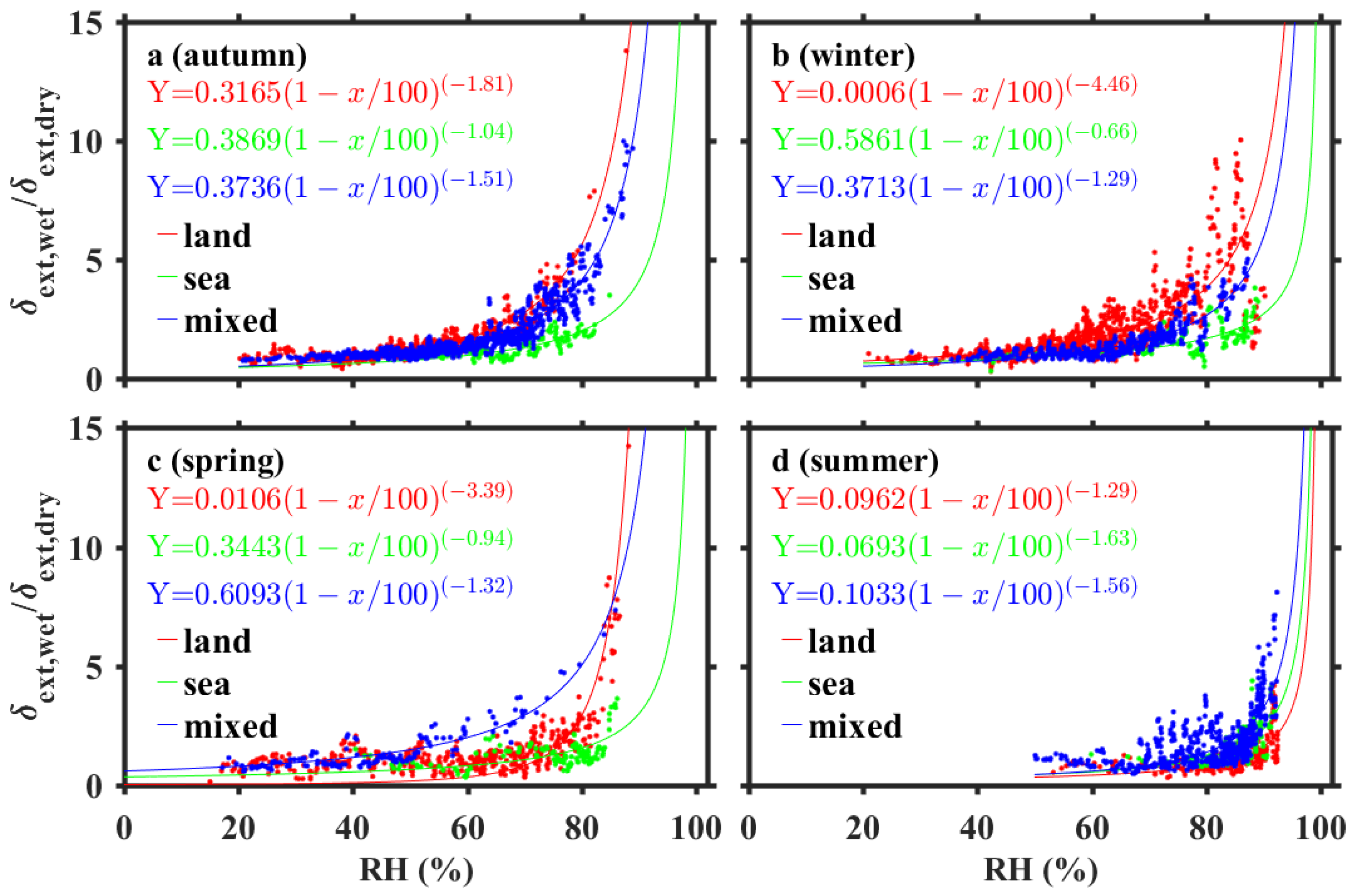
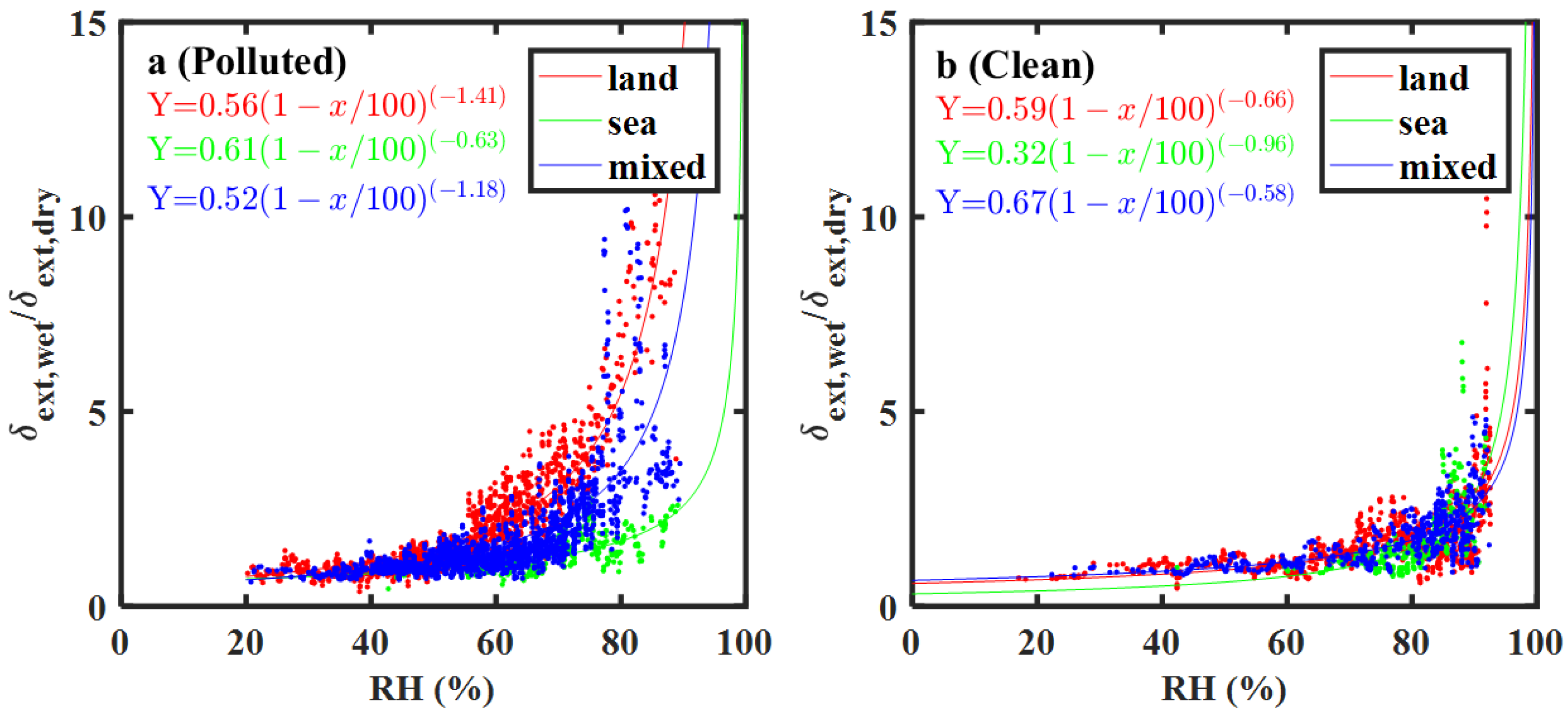
| Technical Specification | Data | Measurement Range | Accuracy | Resolution | Temporal Resolution |
|---|---|---|---|---|---|
| WXT520 | RH | 0–100% RH | ±3% (0–90%RH) ±5% (90–100%RH) | 0.1% RH | 5 s |
| Belfort 6000 | VIS | 200 m~50 km | ±10% | \ | 5 s |
| OPC | PNC | 0.3~12 um | \ | 17–20 channels optional | 60–600 s optional |
| Time | Land Source Index | Sea Source Index | Mixed Aerosol Index |
|---|---|---|---|
| September 2019 | 5 | 3, 8 | 1, 2, 4, 6, 7 |
| October 2019 | 2, 4, 6 | 1 | 3, 5, 7, 8 |
| November 2019 | 3, 5, 7, 8 | 6 | 1,2,4, |
| December 2019 | 2, 3, 5, 6, 8 | 7 | 1, 4 |
| January 2020 | 1, 5 | 8 | 2, 3, 4, 7, 8 |
| February 2020 | 1, 2, 4, 6 | 5 | 3, 7, 8 |
| March 2020 | 1, 3, 5, 8 | 2, 7 | 4, 6 |
| April 2020 | 2, 3, 5, 7, 8 | 4 | 1, 6 |
| May 2020 | 1, 3, 4 | 5, 8 | 2, 6, 7 |
| June 2020 | 1, 6 | 2, 5 | 3, 4, 7, 8 |
| July 2020 | 3, 6 | 4, 7 | 1, 2, 5, 8 |
| August 2020 | 1, 3, 6, 8 | 2, 4 | 5, 7 |
| Time | Land Source (%) | Sea Source (%) | Mixed Aerosol (%) |
|---|---|---|---|
| September 2019 | 6.34 | 26.67 | 66.99 |
| October 2019 | 39.38 | 9.38 | 51.25 |
| November 2019 | 48.88 | 6.5 | 44.62 |
| December 2019 | 66.85 | 6.27 | 26.88 |
| January 2020 | 40.5 | 5.59 | 55.25 |
| February 2020 | 65.08 | 6.8 | 28.13 |
| March 2020 | 67.6 | 11.99 | 20.4 |
| April 2020 | 57.97 | 9.34 | 32.69 |
| May 2020 | 40.9 | 28.51 | 30.59 |
| June 2020 | 28.44 | 34.8 | 36.75 |
| July 2020 | 18.8 | 27.36 | 53.84 |
| August 2020 | 50.47 | 15.36 | 34.17 |
| Season | Land Source | Sea Source | Mixed Aerosol | |||||||||
|---|---|---|---|---|---|---|---|---|---|---|---|---|
| A | B | RMSE | R-Square | A | B | RMSE | R-Square | A | B | RMSE | R-Square | |
| autumn | 0.3165 | 1.81 | 0.34 | 0.92 | 0.3869 | 1.04 | 0.26 | 0.65 | 0.3736 | 1.51 | 0.42 | 0.89 |
| winter | 0.0006 | 4.46 | 1.52 | 0.46 | 0.5864 | 0.66 | 0.47 | 0.49 | 0.3713 | 1.29 | 0.35 | 0.79 |
| spring | 0.0106 | 3.39 | 0.89 | 0.89 | 0.3443 | 0.94 | 0.54 | 0.32 | 0.6093 | 1.32 | 0.35 | 0.89 |
| summer | 0.0962 | 1.29 | 0.52 | 0.41 | 0.0693 | 1.63 | 0.51 | 0.50 | 0.1033 | 1.56 | 0.78 | 0.49 |
| Aerosol Source | Period 1 (Polluted) | Period 2 (Clean) |
|---|---|---|
| Land source | y = 0.56(1 − x/100) − 1.41 | y = 0.59(1 − x/100) − 0.66 |
| Sea source | y = 0.61(1 − x/100) − 0.63 | y = 0.32(1 − x/100) − 0.96 |
| Mixed aerosol | y = 0.52(1 − x/100) − 1.18 | y = 0.67(1 − x/100) − 0.58 |
Publisher’s Note: MDPI stays neutral with regard to jurisdictional claims in published maps and institutional affiliations. |
© 2022 by the authors. Licensee MDPI, Basel, Switzerland. This article is an open access article distributed under the terms and conditions of the Creative Commons Attribution (CC BY) license (https://creativecommons.org/licenses/by/4.0/).
Share and Cite
Liu, N.; Cui, S.; Luo, T.; Chen, S.; Yang, K.; Ma, X.; Sun, G.; Li, X. Characteristics of Aerosol Extinction Hygroscopic Growth in the Typical Coastal City of Qingdao, China. Remote Sens. 2022, 14, 6288. https://doi.org/10.3390/rs14246288
Liu N, Cui S, Luo T, Chen S, Yang K, Ma X, Sun G, Li X. Characteristics of Aerosol Extinction Hygroscopic Growth in the Typical Coastal City of Qingdao, China. Remote Sensing. 2022; 14(24):6288. https://doi.org/10.3390/rs14246288
Chicago/Turabian StyleLiu, Nana, Shengcheng Cui, Tao Luo, Shunping Chen, Kaixuan Yang, Xuebin Ma, Gang Sun, and Xuebin Li. 2022. "Characteristics of Aerosol Extinction Hygroscopic Growth in the Typical Coastal City of Qingdao, China" Remote Sensing 14, no. 24: 6288. https://doi.org/10.3390/rs14246288
APA StyleLiu, N., Cui, S., Luo, T., Chen, S., Yang, K., Ma, X., Sun, G., & Li, X. (2022). Characteristics of Aerosol Extinction Hygroscopic Growth in the Typical Coastal City of Qingdao, China. Remote Sensing, 14(24), 6288. https://doi.org/10.3390/rs14246288







